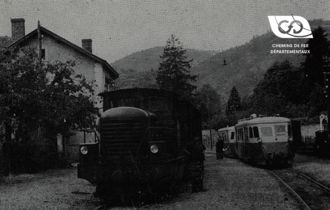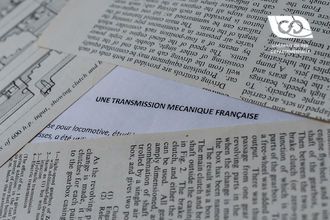In order to reduce construction costs, maintenance requirements, drive train fatigue and fuel consumption, the "mechanical transmission" solution for high horsepower has not had its last word. The simplicity of the device described seems to protect it from costly damage since it uses only a conventional gear combination that can be oversized to transmit very high power with a low work rate.
The different justifications
- A - To stop the gearbox components quickly, it is advisable to reduce their moments of inertia as much as possible. In this field, there are no longer any requirements due to the dimensioning of the "synchros" which determined the dimensions of the sprockets to be dogged, their modulus, number of teeth, centre distances, etc... It therefore becomes easy to significantly reduce these moments of inertia to such an extent that it is possible to build a 500 bhp gearbox with 8 gears, whose PD2 is equal to that of the 250 bhp 6-speed synchronised gearboxes.
- B - The brake must be calculated to withstand, without risk of overheating or wear, the work corresponding to the highest speed combination, as it is for this combination that the energy to be absorbed is maximum due to the higher rotational speeds of the intermediate and output shafts of the gearbox. If a locomotive has N gears, the n{suli}th {/suli}speed is only passed every second N gear change.
- If the brake is calculated for the N{suli}th{/suli} speed, a fortiori for the (N-1) other speeds it will only support a fraction of its capacity.
- C - Either a gearbox whose input shaft is immobilised, the dogging of a pinion is facilitated by an angular displacement of the output shaft: the dogging inputs are cut appropriately so as to cause this rotation in the favourable direction, whatever the new combination, the drag of the freewheel facilitating gear shifting when the vehicle is in motion.
- D - The clutch has its role reduced to re-engaging the gearbox which is easy since to re-engage it in one second it only takes about 1/4 of the engine torque. Under no circumstances can it be subjected to a torque greater than that of the engine. Such a torque supplement could only come from :
- E - It is easy to notice that a gear change designed in this way is accompanied by a certain amount of work absorption.
Calculation of the average power
Let's see by a quick calculation what is the average power absorbed by the "Asynchro" process. To do this, we consider the 8-speed "Asynchro" gearbox with a power of 500,600 hp, and we will assume a continuous regime of gear changes at the rate of one change per minute by shifting through the entire range from 1e to 8°, and downshifting from 8e to first without interruption. This is far beyond the scope of practical use.
We have made these calculations for the 8-speed gearbox (fig. 3) assuming that a braking torque is applied to the input rotating at I 500 rpm (this case corresponds to the upshift) so that the gearbox is stopped in 1 sec, 5.
You can see that you have to apply in :
| Ie speed one torque | Cf1 = 3.5 m kg |
| 2e" | Cf2 = 5, - m kg |
| 3e" | Cf3 = 6, - m kg|
| 4e" | Cf 4 = 7.5 m kg|
| 5e" | Cf5 = 8.5 m kg|
| 6e" | Cf 6= 14.5 m kg|
| 7e" | Cf7= 17, - m kg|
| 8e" | Cf8= 31, - m kg
In addition, the clutch-brake itself requires a braking torque Cf= 1.8 m/kg to stop it.
The work of a torque being equal to T = 2 ? n C, and the speed going from 25 t/sec to 0 in 1 sec,5 the braking is carried out on I/2 (25 x 1.5), i.e. 18.75 revolutions
hence TTkgm = 116 Cm/kg
The sum of the work for the gear increase is therefore
equal to ?T =116 (Cf1+ Cf2 + ... + Cf7) + 116 (7 x Cf))
?T = 8,650 kgm
An analogous calculation for speed reduction gives 5,930 kgm
At the rate of one change per minute, the complete cycle takes 14 minutes, i.e. a work T = 8 650 kgm + 5 930 kgm = 14 580 kgm which corresponds to an average absorbed power
T
P= / t = 14 minutes
t
hence in hp P= 14 580/(75 x 60 x 14) = 0.231 hp
The loss of power therefore does not reach 1/4 horsepower.
Another more telling figure:
Let's suppose that the brake is fully insulated, and that its water value is 1 calorie (equivalent to 1 litre of water); after 14 minutes the temperature will have risen by 34.3 degrees centigrade.
Let's suppose again an extreme case, where we go from 7e to 8e, and from 8e to 7e, every minute; by a similar calculation we find an average power consumption equal to
P2 = 0.45 hp
These figures should be compared to the power lost in a hydraulic torque transformer, which under the best conditions has only 84% efficiency.
The power loss for a 500 to 600 hp engine is therefore 80 to 100 hp.
As for electric transmissions, their efficiency is not better, so power losses are of the same order.
A rule should therefore be established for diesel locomotives to indicate their power:
- For electric locomotives the nominal power is the power on the shaft of the electric motors which is very close to the power at the rim.
- For diesel locomotives their power has been wrongly defined, in our opinion, by the power of the diesel engine setting. This practice has the effect of ignoring the auxiliaries, the efficiency of the transmission or the inability of the latter to use in all cases the nominal power of the engine, as we have just seen, for the mechanical transmission.
This is deceptive since only the power at the rim is of interest.
It would therefore be desirable to define the power of a diesel locomotive by its average power at the rim at the minimum continuous speed and at the maximum speed.
The curves in Figure 5 show that this fair definition gives the mechanical transmission an advantage of more than 10%.
Brake wear
The brake is multi-disc and operates either dry or in oil. Properly calculated, it does not fear overheating, which gives it great durability. Indeed, for these "sintered" type linings, the manufacturer admits a wear of 1/2 mm in thickness for 20 Million kgm per dm2.
Suppose that we brake at the rate of I coup minute in the worst case, i.e. at the passage from the 7e to the 8e speed, a brake coup absorbs
116 (17+ 1.8) = 2,180 kgm
The brake has 20 dm2 of lining, it is allowed to give :
20,000,000 x 20 / 2,180 = 183,500 brake strokes, i.e. at a rate of 60 per hour: 183,500/ 60 = 3,060 hours.
It is clear, that there is no problem with the brake.
source : Revue Générale des Chemins de Fer, June 1957





